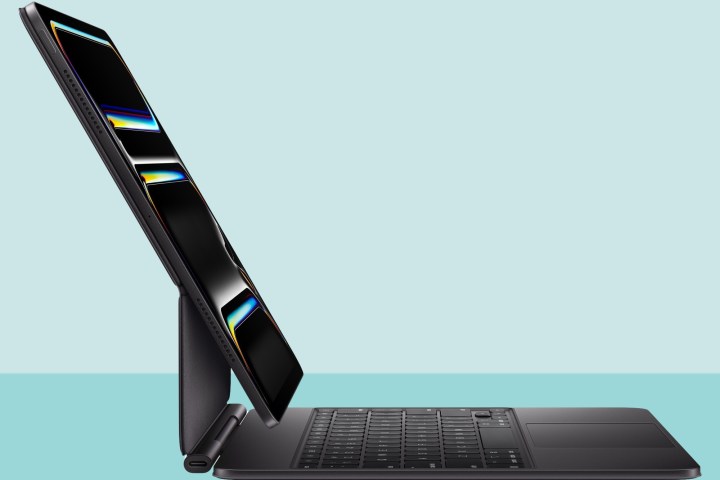
The line between the iPad Pro and the MacBook Air has always been slim. Despite being very different devices, they’re the two 13-inch devices in Apple’s lineup — and with the updated M4 iPad Pro, they are more competitive with each other than ever.
There’s a lot we still don’t know about the M4 iPad Pro, but here’s a preliminary look at how the two devices stack up against each other.
Specs
| iPad Pro 13-inch (M4) | MacBook Air 13-inch (M3) | |
| Dimensions | 11.09 inches x 8.48 inches x 0.2 inches | 11.97 inches x 8.46 inches x 0.44 inches |
| Weight | 1.28 pounds | 2.7 pounds |
| Processor | Apple M4 (9-core) Apple M4 (10-core) |
Apple M3 (8-core) |
| Graphics | 10-core | 8-core 10-core |
| Neural engine | 16-core 120GB/s memory bandwidth | 16-core |
| RAM | 8GB 16GB |
8GB 16GB 24GB |
| Display | 13-inch OLED 2752 x 2064, 120Hz | 13.6-inch LED 2560 x 1664, 60Hz |
| Storage | 256GB 512GB 1TB 2TB |
256GB 512GB 1TB 2TB |
| Ports | 1x Thunderbolt / USB 4 | 1x MagSafe 3 2x Thunderbolt / USB 4 1x 3.5mm audio jack |
| Wireless | Wi-Fi 7 and Bluetooth 5.3 | Wi-Fi 6E and Bluetooth 5.3 |
| Webcam | 12 megapixel, ultrawide camera | 1080p FaceTime camera |
| Operating system | iPadOS 17 | macOS Sonoma |
| Battery | 39 watt-hour | 52.6 watt-hour |
| Price |
$1,299+ | $1,099+ |
Pricing
The iPad Pro M4 starts at $1,299 for the 13-inch model, which comes with 8GB of RAM and a 256GB SSD. Meanwhile, the MacBook Air 13-inch M3 undercuts that by $200, coming in at $1,099 for the same configuration of memory and storage. To make things closer to fair, though, I’ll add in the $100 to that starting configuration to bring the GPU up to 10 cores. Now, there’s only a $100 difference between the two.
But let’s not forget, in order to make the iPad Pro a true laptop replacement, you’ll need to pay an extra $349 for the Magic Keyboard, bringing the price up to $1,648 (and that doesn’t include an Apple Pencil, if you want one of those). Ouch. For a similar price, you could instead get a MacBook Air with 16GB of RAM and 1TB of storage.
Design
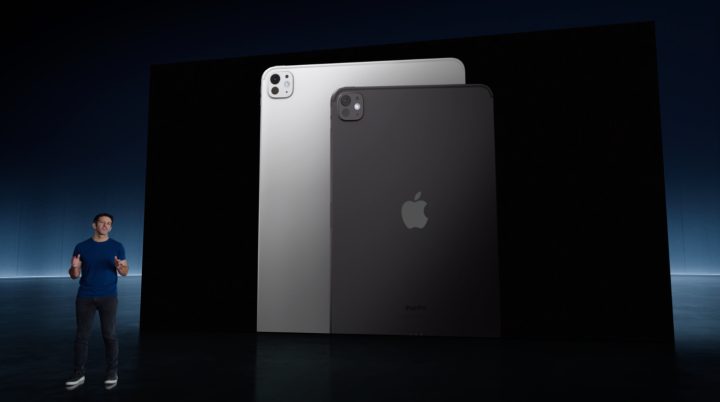
The M4 iPad Pro is a completely redesigned iPad, and certainly the most striking there’s ever been. Of course, a tablet is a tablet — a sheet of glass and not much more — but the the dimensions of this device are what makes it so eye-catching. Apple claims that it’s the company’s thinnest product ever made at just 0.2 inches thick.
However, those dimensions change quite a bit once you convert this into a proper MacBook Air competitor — namely, by adding the new Magic Keyboard. We don’t know exactly quite how much thickness or weight this adds, but the original Magic Keyboard made the previous iPad 0.6 inches thick, which would be thicker even than the MacBook Air. That’s important, because if we’re comparing these two machines side by side in terms of day-to-day work and travel, the MacBook Air may end up being the overall more portable device.
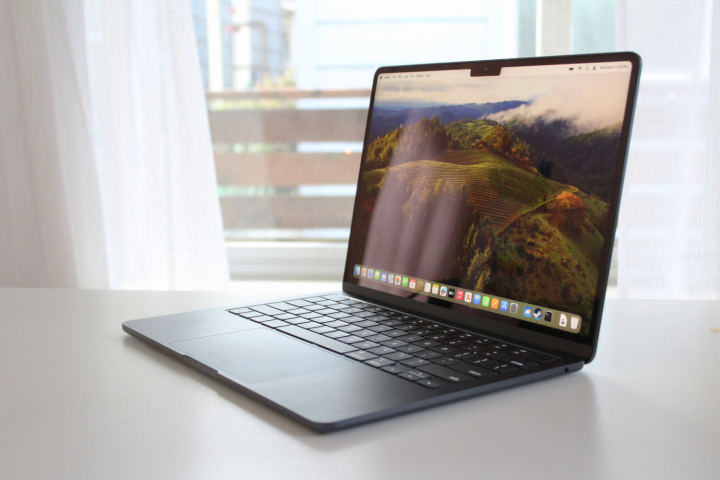
Of course, all the typical differences between iPads and MacBooks come into play here. The MacBook hinge offers a much wider range of angles, while the iPad Pro’s ability to be used as a tablet is a huge benefit. I will say, though, if you’re primarily using this as a laptop replacement, that might be a less-used feature than you imagine.
In terms of color options, the iPad Pro offers just two colorways: Space Black and Silver. The MacBook Air has four: Silver, Space Gray, Starlight, and the newest addition, Midnight.
Display

With the introduction of the new iPad Pro, there’s never been a wider gap in display quality between the iPad Pro and MacBook Air. After all, there was already a gap between the previous-gen iPad Pro’s mini-LED screen and the MacBook Air. But bringing OLED to the iPad Pro takes it to the next level. According to what Apple has said so far, it rectifies the OLED’s brightness problem by using two OLED panels under the hood, stacked on top of each other. The result is an OLED screen that is even brighter and has better contrast than the current MacBook Pro’s mini-LED screen. Suffice it to say, it’s a big deal.
The MacBook Air’s display, on the other hand, represents the extreme other end of the spectrum. Don’t get me wrong — it’s a perfectly suitable screen for a laptop of this type. It has relatively good color accuracy and can get surprisingly bright. But we’re seeing more and more OLED laptops on the Windows side land at under $1,000, such as the Asus Zenbook Q425. That laptop’s OLED screen might not be as bright as Apple’s, but it does look beautiful otherwise. It also comes with a 120Hz refresh rate, which points out another downside to the MacBook Air’s screen. Unlike the iPad Pro, which has a screen that can go up to 120Hz, the MacBook Air is locked at 60Hz. This makes motion and animation feel a bit clunky by comparison.
Lastly, it’s worth mentioning that the iPad Pro comes with a touchscreen — and the MacBook Air does not. You’ll have to take that one up with Apple.
Keyboard and ports
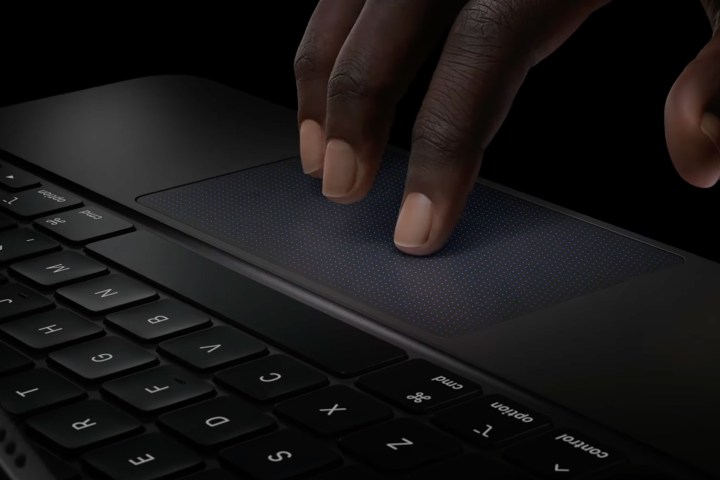
As mentioned, there’s a new Magic Keyboard designed specifically for this new iPad Pro. The big change is that it now has a larger haptic feedback trackpad, as well as a 14-key function row of keys across the layout of the keyboard. These are two exceptional changes that make the iPad Pro far more useful — and far more like a MacBook. That was a point made from the virtual stage by Apple, in fact.
I haven’t used this keyboard yet, but there’s every reason to suspect that it will better replace a MacBook Air’s keyboard than the original Magic Keyboard. The layout of the MacBook Air is a bit more spacious, of course, and I appreciate those full-sized function keys over the half-sized ones of the iPad Pro. But those are nitpicks. These are much more comparable now than they’ve ever been before.
The port selection isn’t so different either. Both devices have just two Thunderbolt ports, so long as you’ve got the iPad Pro connected to the Magic Keyboard. The one advantage the MacBook Air has over the iPad Pro is the addition of the MagSafe 3 power connection. By offering a dedicated power plug, that frees up your other two ports. The other major benefit of the MacBook Air is the inclusion of the headphone jack — something the iPad has not had for many years.
Performance and battery life
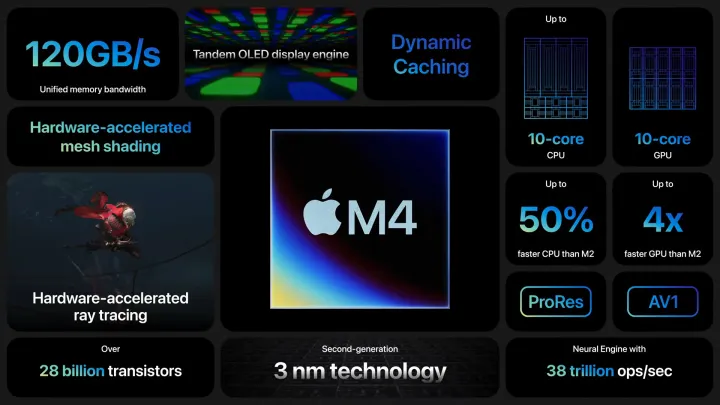
The fact that the M4 has ended up on the iPad Pro before a MacBook has surprised us all. Just how big of a deal is this new chip? Well, we won’t know for sure until we can test the thing out ourselves, but Apple has certainly thrown out some rather big statements. For example, the M4 is supposedly four times faster than the M2 and 10 times faster than the M1. In applications, the M4 in the iPad Pro is said to be 50% faster in ProCreate and to be able to handle four times more streams in ProRES Raw in Premiere Pro.
There hasn’t been much in terms of comparison to the M3, so we’ll have to wait and see how those numbers play out. I’m especially interested to see if the GPU performance has been accelerated at all, considering how big of a graphical jump the M3 was over the M2.
The other important factor is AI performance. Apple is about to pull back the curtain on its AI developments at its Worldwide developers Conference (WWDC) next month, and the improved Neural Engine in the M4 is an important part of the equation. Capable of 38 TOPS (trillion operations per second), the M4 is a huge step up from the M3, as it more than doubles the 18 TOPS of the M3. How this will all play out is to be determined, but it’s clear that the M4’s biggest advantage may be its AI capabilities.
Interestingly, the M3 MacBook Air will likely still have better battery life. The iPad Pro has a much small battery in it, giving the M3 MacBook Air a significant upper hand.
It still comes down to software

The iPad Pro is a significantly more expensive device than the MacBook Air, but it comes with many benefits. It has a much better screen, a faster chip inside, a better camera (in fact, it has two!), Face ID, and a touchscreen. That’s a lot. It certainly adds up to a much more premium device.
With the MacBook Air, you get more configuration options, a larger keyboard and trackpad, better battery life, a headphone jack, and an overall more portable form factor. The price difference is the biggest draw, though. After all, you could buy a MacBook Air M3 and a new iPad for the price of the iPad Pro M4.
But ultimately, the question of which of these two devices you should buy will always come down to software and how you intend to use them. Most people will opt for the MacBook Air as a default, and I think that’s a safe bet. But the iPad Pro does some things you could never do with a Mac, and that screen sure is tempting.
Of course, we won’t know for sure until we’ve reviewed the iPad Pro M4 after it releases. For now, the comparison between the iPad and Mac lineup has never been more interesting.
Editors’ Recommendations
Services Marketplace – Listings, Bookings & Reviews
